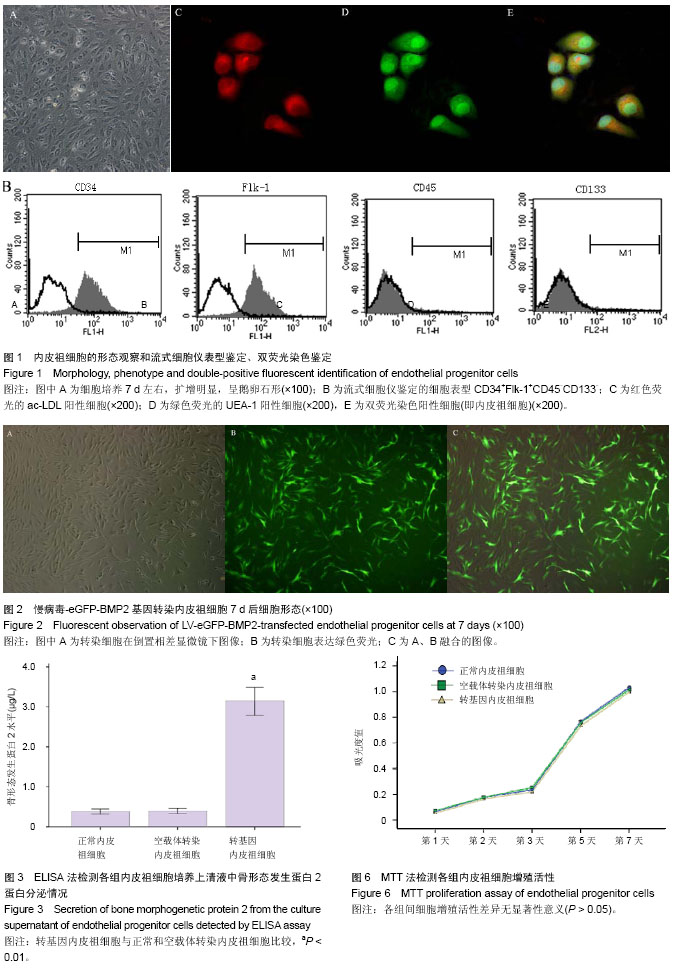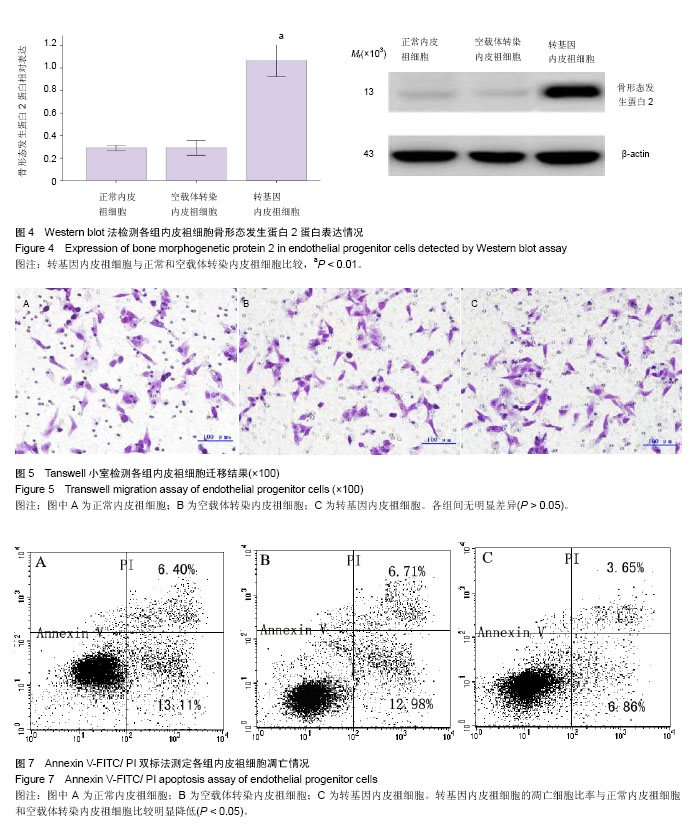| [1] Asahara T, Murohara T, Sullivan A,et al. Isolation of putative progenitor endothelial cells for angiogenesis.Science. 1997; 275(5302):964-967.
[2] Hristov M, Erl W, Weber PC. Endothelial progenitor cells: mobilization, differentiation, and homing. Arterioscler Thromb Vasc Biol. 2003;23(7):1185-1189.
[3] Zhang Y, Ingram DA, Murphy MP,et al. Release of proinflammatory mediators and expression of proinflammatory adhesion molecules by endothelial progenitor cells.Am J Physiol Heart Circ Physiol. 2009;296(5): H1675-1682.
[4] Ferrari N, Glod J, Lee J,et al. Bone marrow-derived, endothelial progenitor-like cells as angiogenesis-selective gene-targeting vectors.Gene Ther. 2003;10(8):647-656.
[5] Chen L, Wu F, Xia WH,et al.CXCR4 gene transfer contributes to in vivo reendothelialization capacity of endothelial progenitor cells.Cardiovasc Res. 2010;88(3):462-470.
[6] Park SJ, Baek SH, Oh MK,et al. Enhancement of angiogenic and vasculogenic potential of endothelial progenitor cells by haptoglobin.FEBS Lett. 2009;583(19):3235-3240.
[7] Liu JW, Dunoyer-Geindre S, Blot-Chabaud M,et al. Generation of human inflammation-resistant endothelial progenitor cells by A20 gene transfer. J Vasc Res. 2010; 47(2): 157-167.
[8] ten Dijke P, Korchynskyi O, Valdimarsdottir G, et al. Controlling cell fate by bone morphogenetic protein receptors. Mol Cell Endocrinol. 2003;211(1-2):105-113.
[9] 单世民,裴凌,谭文斐. rhbmp-2对内毒素致急性肺损伤大鼠肺动脉构型重建的影响[J].中华麻醉学杂志, 2007,27(6):541-546.
[10] Wang K, Gong J, Pei L,et al.The effect of rhBMP-2 on pulmonary arterioles remodeling in endotoxin-induced acute lung injury in rats.Clin Exp Med. 2013;13(3):187-192.
[11] Cao JP, He XY, Xu HT,et al. Autologous transplantation of peripheral blood-derived circulating endothelial progenitor cells attenuates endotoxin-induced acute lung injury in rabbits by direct endothelial repair and indirect immunomodulation. Anesthesiology. 2012;116(6):1278-1287.
[12] Lam CF, Roan JN, Lee CH,et al.Transplantation of endothelial progenitor cells improves pulmonary endothelial function and gas exchange in rabbits with endotoxin-induced acute lung injury.Anesth Analg. 2011;112(3):620-627.
[13] Rabelink TJ, de Boer HC, de Koning EJ,et al. Endothelial progenitor cells: more than an inflammatory response. Arterioscler Thromb Vasc Biol. 2004;24(5):834-838.
[14] Capla JM, Grogan RH, Callaghan MJ,et al. Diabetes impairs endothelial progenitor cell-mediated blood vessel formation in response to hypoxia.Plast Reconstr Surg. 2007;119(1):59-70.
[15] Liu SB, Hu PZ, Hou Y,et al. Recombinant human bone morphogenetic protein-2 promotes the proliferation of mesenchymal stem cells in vivo and in vitro.Chin Med J (Engl). 2009;122(7):839-843.
[16] Raida M, Heymann AC, Günther C,et al. Role of bone morphogenetic protein 2 in the crosstalk between endothelial progenitor cells and mesenchymal stem cells.Int J Mol Med. 2006;18(4):735-739.
[17] Smadja DM, Bièche I, Silvestre JS,et al. Bone morphogenetic proteins 2 and 4 are selectively expressed by late outgrowth endothelial progenitor cells and promote neoangiogenesis. Arterioscler Thromb Vasc Biol. 2008;28(12):2137-2143.
[18] Teichert-Kuliszewska K, Kutryk MJ, Kuliszewski MA,et al. Bone morphogenetic protein receptor-2 signaling promotes pulmonary arterial endothelial cell survival: implications for loss-of-function mutations in the pathogenesis of pulmonary hypertension.Circ Res. 2006;98(2):209-217.
[19] Picanco-Castro V, de Sousa Russo-Carbolante EM, Tadeu Covas D. Advances in lentiviral vectors: a patent review. Recent Pat DNA Gene Seq. 2012;6(2):82-90.
[20] 尹承慧,邱俊钦,曾昭勋,等.腺病毒介导的人骨形态发生蛋白2基因转染骨髓间充质干细胞[J].中国组织工程研究, 2013,17(14): 2488-2494. |

